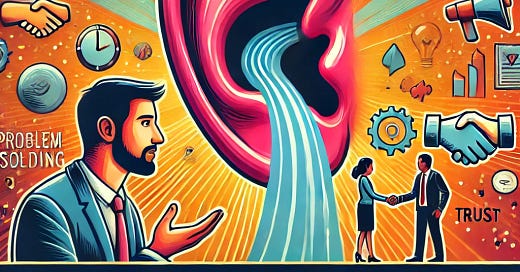Let’s be real for a second: how often do you actually listen? No, not the “smile and nod while planning dinner in your head” kind of listening. I mean the real deal, where you put your phone down, stop mentally arguing with that annoying person from three weeks ago, and actually listen.
You see, when it comes to communication, we’ve all been told that the way to win is by being good at talking. But here’s the kicker: the secret weapon in any effective conversation isn’t the person with the smoothest speech, it’s the one who can actually hear what the other person is saying.
Here’s why listening isn’t just a nice-to-have skill, but the MVP of communication:
Reason #1: Listening Improves Understanding (You Won’t Keep Misunderstanding Your Friend’s Sarcastic Texts)
Listening isn’t just about hearing words; it’s about grasping the context, emotions, and unspoken meaning behind them. Active listening means absorbing the full picture—words, tone, body language, the whole nine yards.
Think of it like trying to piece together a puzzle. If you’re only half-listening, it’s like trying to solve that puzzle while your dog runs off with half the pieces. Good luck figuring out what the other person really means in that scenario.
Reason #2: Listening Builds Trust (Trust Me, I’m Listening… For Real This Time)
Ever notice how being listened to feels like a warm hug for your ego? When people feel heard, they feel valued. And when people feel valued, they’re more likely to open up, share their ideas, and—get this—actually trust you. That’s how you build a solid connection with others.
Think of listening like watering a plant. Every time you listen, you’re nurturing the trust between you and the speaker. Skip a few watering sessions (aka ignore what they’re saying), and, well… good luck reviving that crispy relationship.
Reason #3: Listening Enhances Problem-Solving (How to Avoid Fixing the Wrong Problem Like an Overenthusiastic Handyman)
Let’s face it, we’re all guilty of rushing to offer solutions without really understanding the issue. You know, that moment where you interrupt someone with, “Oh, I know how to fix that!” only to realize halfway through that you’re solving a completely different problem. Classic.
When you actively listen, you gather all the necessary information before jumping to conclusions. This leads to—surprise!—better decision-making and more creative solutions. No more metaphorically trying to fix a leaky sink by repainting the walls.
So How Do You Become a Jedi Master at Listening?
Here are three simple techniques that will take your listening skills from amateur to expert:
1. Listen Actively (AKA Stop Checking Your Phone Every Two Minutes)
Active listening means you’re all in. No distractions, no half-baked attention. Focus on the speaker like they’re telling you the winning lottery numbers. Give them nonverbal cues, like nodding, and throw in a few “Mhm, I see”s here and there. It shows you’re present, engaged, and, importantly, awake.
Imagine you’re a high-stakes poker player. If you’re not fully tuned into every tiny move, you’re going to lose—fast. The same goes for conversations: don’t lose your focus, or you’ll miss the big “tell” in their words.
2. Ask Clarifying Questions (No, You Don’t Always Know What They Mean)
Here’s a revolutionary concept: if you don’t understand something, just ask. No more pretending you know what they mean, only to realize halfway through the conversation that you’ve been wildly off track. Asking for clarification isn’t admitting defeat; it’s making sure you’re on the right road map.
Instead of assuming, try questions like, “Can you explain that a bit more?” or “What do you mean by that?” Not only does this help avoid misunderstandings, but it also shows the speaker you’re genuinely trying to understand them. Which, believe it or not, they’ll appreciate.
3. Paraphrase and Summarize (The “So What You’re Saying Is” Move)
Once the speaker has finished, hit them with the classic paraphrase. “So, what I heard is…” or “It sounds like you’re saying…” is a great way to ensure you’ve got the right message. It also gives the speaker a chance to correct you if you’re off the mark.
Think of it like that game where you whisper a phrase into someone’s ear, and by the time it gets to the end, it’s wildly distorted. Paraphrasing is how you stop that distortion from happening. Plus, it confirms that you’re on the same wavelength.
The Bottom Line: Shut Up and Listen
So, the next time you’re in a conversation—whether it’s with a coworker, partner, or your grandmother telling the same story for the 17th time—try practicing these listening techniques. You might be surprised at how much smoother your conversations go when you’re not just waiting for your turn to talk.
The best part? By simply listening, you’ll not only avoid countless misunderstandings, but you’ll also build stronger, more trusting relationships and improve your problem-solving skills. Not bad for just keeping your mouth shut for a minute, right?
Sign Off: Listening is like flossing—we know we should do it more, but most of us don’t. Well, here’s your friendly reminder to make it a daily habit! Go on, give it a shot—you might just save yourself from an argument or two (or ten).
PS: If you're still listening (pun intended), drop a comment on which of these tips you’re going to try out first. And no, just saying you'll try isn't enough—give us the juicy details of your listening escapades!
4o












Share this post